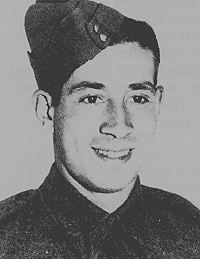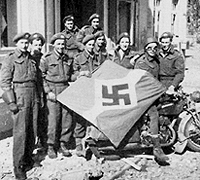Decorated by Destiny

Charles Byce, shown at age 24, was the only member of his regiment—the Lake Superior Regiment—to earn both the Distinguished Conduct Medal and the Military Medal. He displayed fearless leadership in winning both gallantry awards. (Charles Byce)
Considering his father's overseas exploits, one would think fate had chosen Charles Henry Byce to be a military hero. His mother, Louisa Saylors, a Cree from Moose Factory, Ontario, had married Henry Byce, a non-Indigenous man from Westmeath. When Charles was born in 1917 in Chapleau, the First World War was still raging, and his father was fighting in Europe, meriting two decorations for valour: the DCM plus France's Medaille militaire. Two decades later, 23-year-old Charles Byce joined the Lake Superior Regiment (Motor—the "Lake Sups"—and began a remarkable journey, practically tracing his father's path. When it was over, Byce had become the only man in his regiment to earn both the Distinguished Conduct Medal (DCM) and the Military Medal (MM).63
Byce earned his first decoration for valour—the MM—in the Netherlands in January 1945. By that time, the Allies had established themselves in France and Belgium and, in another month, would launch an offensive for a final push over the Rhine into Germany.
Before dawn on January 21, Acting Corporal Byce and 23 other Lake Sups set off in row-boats to cross the Maas River. Their mission was to sneak behind enemy lines and bring back German prisoners so information on enemy units could be gathered. Byce headed a five-man team charged with providing cover for the reconnaissance group.
Soon after it had landed on enemy territory, the reconnaissance group was fired upon from three German positions. Byce personally located two of them and silenced them with grenades. He also managed to obtain information from a German prisoner before the group started back. The official history of the regiment describes the events that followed:
By this time the sky was filled with baleful red and yellow flares, and enemy machine-guns and light mortars were spurting into action . . . . As the patrol hurried along the dyke several grenades hurtled through the air. Fortunately they exploded harmlessly... but they did serve to reveal the location of two more enemy soldiers. Again Corporal Byce took the initiative. He charged the German dugout and into it hurled a 36 [calibre] grenade.64
The patrol escaped safely and, afterward, Byce became one of more than 1,200 Canadians to receive the MM.65 His citation commended the corporal for his "coolness" and "devotion to duty" and credited him with the mission's success.
Some six weeks later, Byce became one of only 162 Canadians to earn the DCM during the Second World War.66 The Rhineland Campaign was well under way, but enemy defences still blocked the Allied path into Germany. This was the enemy's last major line of defence and it would not be broken easily. Counter-attacks were fierce and numerous.
On March 2, 1945, the Lake Sups engaged in the most difficult fighting the regiment had known. At 4 a.m., Acting Sergeant Byce and the rest of C Company set out to occupy a group of buildings south of the Hochwald Forest. By 6 a.m., they had accomplished their goal, but the day's first light revealed their location to the enemy.
C Company was bombarded with shells and mortar. All of its tanks were destroyed and casualties mounted quickly. The victims included every officer—even the company commander. Meanwhile, four enemy tanks were approaching. The regimental history explains what happened next:
In the confusion and general disorder the enemy closed in upon C Company's position. Grimly the Lake Sups held on, the perimeter of their defences becoming smaller and smaller, and their escape corridor to the rear, narrower and narrower . . . . With ferocity and courage [Sergeant] Byce, now commanding the remnants of C Company, fought as long as he could; then gathering what few men he was able to find about him he made his way back through the bullet-strewn escape alley.67

In Germany, in April 1945, a group from the Lake Superior Regiment display the enemy flag they had captured. (Alexander Stirton / Department of National Defence / Library and Archives Canada / PA-137250)
It was 3 p.m. when Byce ordered the retreat of his men. He spent the rest of the afternoon behind his group, sniping at enemy infantry so they could not trace the company's withdrawal.
Again, his citation was impressive:
The magnificent courage and fighting spirit displayed by this NCO when faced with almost insuperable odds are beyond all praise. His gallant stand, without adequate weapons and with a bare handful of men against hopeless odds will remain, for all time, an outstanding example to all ranks of the Regiment.
Byce and the Lake Sups had advanced into Germany by the time the war in Europe ended on May 8, 1945. The following month, he was sent to England. He returned to Canada in September 1945.
- Date modified: